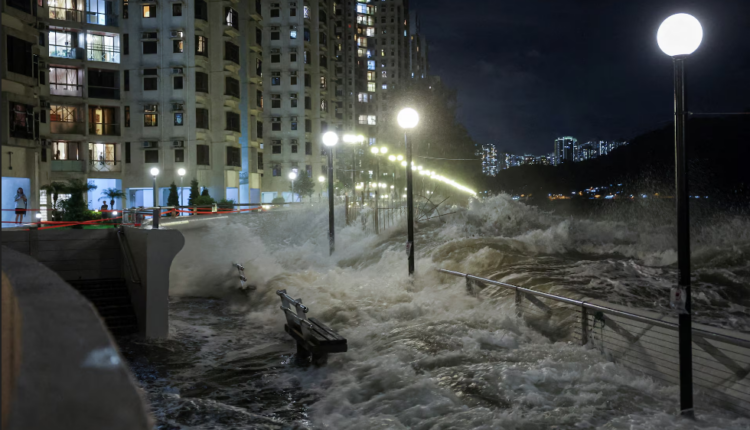Typhoon slams southern China, killing 15 in Taiwan
Typhoon Ragasa, which a few days ago was the strongest storm on earth so far this year, brought finance hub Hong Kong and swathes of southern China to a standstill on Wednesday, after barreling through remote islands in the Philippines and mountainous regions of Taiwan.
Packing hurricane-force winds, the storm has left a trail of damage, triggering landslides, flooding and huge waves, and is now bearing down on China’s Guangdong province, where massive cities like Shenzhen and Guangzhou are located.
In Taiwan, at least 15 people have died and rescuers were scrambling to locate 17 others still missing Wednesday afternoon local time after a natural dam holding back a recently formed lake collapsed a day earlier, unleashing 68 million tons of water and flooding the nearby Guangfu township.
Debris from a landslide in July had formed the natural dam, and authorities had been warning for weeks the remote lake could overflow by October. At a news conference on Wednesday, officials said assessments showed it wasn’t feasible to dredge, siphon or otherwise remove the dam barrier – so they opted to monitor the situation instead.
Before the typhoon hit, authorities said they had issued multiple warnings and evacuation advisories to residents who could be impacted if the lake overflowed.
But their October prediction didn’t take heavy rainfall into account – and any strong typhoons could have sped up that process, said Kuo-Lung Wang, a professor at Taiwan’s National Chi Nan University.
A large bridge in Hualien was also washed away by the rush of water following the collapse of the natural dam.
Southern China battered
The Philippines, Taiwan and southern China experience multiple typhoons annually, but the human-caused climate crisis has made storms more unpredictable and extreme.
As the storm approached the international finance hub of Hong Kong early Wednesday, it brought lashing winds that felled trees and ripped scaffolding off buildings, reaching maximum gusts of 168 kilometers per hour (104.39 mph). One CNN reporter on the ground saw sea swells pounding the sidewalk near Hong Kong’s iconic harbor.
Video circulating on social media showed storm surges shattering the glass doors of the Fullerton Ocean Park Hotel, a luxury seaside resort, with huge waves gushing into the lobby and sweeping people off their feet.
In a statement to CNN, the hotel said no injuries were reported and that the government had “immediately” mobilized resources to respond.
Photos and video from Macao showed waist-deep water flooding the streets of the tourism and gambling hub, often dubbed the most densely populated city on earth.
The winds have prompted Hong Kong and Macao – together home to more than 8 million people – to issue their highest hurricane warning signal, with schools, businesses and public transit largely closed, including the city’s airport, one of Asia’s busiest. Storm surges of more than 3 meters were recorded in parts of the city by the Hong Kong Observatory.
Footage from Shenzhen, just across the border from Hong Kong, showed massive waves crashing into a coastal park Tuesday night, with winds reaching 181.44 kilometers per hour (112.4 mph).
Other cities along the southern coast of China were bracing for impact, too, with authorities triggering measures to protect those most at risk from storm surges and landslides.
The storm had the equivalent strength of a Category 3 hurricane as it edged towards landfall on mainland China Wednesday afternoon local time.
The country’s southern Guangdong province evacuated 1.89 million people by Tuesday night ahead of the typhoon’s arrival, according to the provincial emergency management department.
In Zhuhai, a coastal city neighboring Macao, residents of seaside high-rises were ordered to evacuate on Tuesday afternoon, according to state media, with many taking refuge with relatives, checking into hotels, or moving into temporary government shelters like school gyms.
One longtime resident, who relocated with her family to a school gymnasium, told local outlet Hongxing News it was the first time in her three decades living in Zhuhai that she had ever been evacuated.
More than 10,000 vessels in Guangdong were relocated to safer waters to avoid the storm, and more than 38,000 firefighters are on standby, according to state-run outlet Xinhua.

